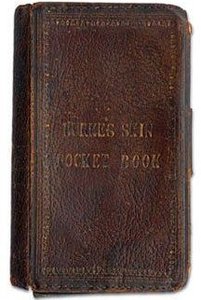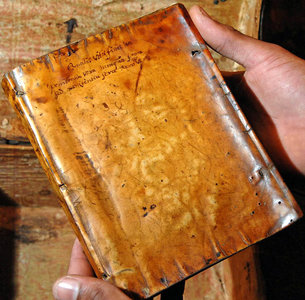The art of binding books in human skin.
Yes that’s right, human skin; it’s not just in the realms of horror that a book is bound in the flayed skin of a human being, it was quite the fashion statement in the late 16th, early 17th century and continued right up until the mid to late 19th century with many examples coming from executed criminals.
The practice seems to be inextricably intertwined with the practice of tanning human skin after a cadaver had been used for dissection purposes, however and why ever it happened there are still examples of Anthropodermic Bibliopegy around today.
In June of 2014 Harvard University confirmed that a book in its possession was, with 99.9% certainty was indeed bound in human skin.
Houghton Library’s 19th century copy of the French writer Arsene Houssaye’s “Des destinees de l’ame” was given to a friend Dr. Ludovic Bouland who had the text, described as “a meditation on the soul and life after death,” bound in the tanned skin of an unclaimed female mental patient who had died from a stroke.
Bouland left a note in the volume explaining what he had done.
“A book about the human soul deserved to have a human covering,” he wrote.


A rather apt ‘donor’ for you next, one William Burke. Rather than dig up corpses to sell for dissection to the private Edinburgh anatomy school run by Robert Knox, Burke, along with his partner William Hare, began killing people instead. They sold more than 15 bodies before they were discovered.
After his trial and execution, there was a public dissection where apparently a section of Burke’s skin ‘went missing’ and shortly after, this little pocket book appeared in Edinburgh, complete with the date of Burke’s execution stamped on the back and for sale to the highest bidder.
One of the few surviving examples in the UK is owned by the Bristol Record Office and made from the skin of the first man to be hanged at Bristol Gaol. Its cover was made with the skin of 18-year-old John Horwood, who was hanged for the murder of Eliza Balsum.
The book contains the details of the 1821 crime, when Horwood, who had become infatuated with Eliza and had threatened to kill her previously. According to the book, Horwood “took up a large stone and with the utmost savage ferocity nearly beat her skull to pieces”.
After his execution Horwood’s body was subjected to the customary public dissection and at the surgeon Richard Smith’s behest, his skin was used to bind papers pertaining to the inquest. The cover is embossed with a skull and crossbones, with the words “Cutis Vera Johannis Horwood”, which when translated means “the actual skin of John Horwood”, added.


And here’s that delightful Dr Ludovic Bouland back again, this time with a book about virginity.
The enclosed text is from the 16th century but Dr Bouland once again felt the need to ensure this book could be judged by its cover and in the late 19th century rebound it in human skin. Once again a note can be found inside explaining the reasoning for the rebinding.
“This curious little book on virginity and the female reproductive functions seems to me worth of a binding appropriate to the subject and covered by a portion of female skin, tanned by myself with sumac. “
Pleasant fellow.
The skin of Father Henry Garnet, a part of the in the 1605 gunpowder plot to blow up the Houses of Parliament (Guy Fawkes anyone?), binds a 1606 record of offenses against him, entitled “A True and Perfect Relation of the Whole Proceedings Against the Late Most Barbarous Traitors, Garnet a Jesuit and His Confederates.”
Although he wasn’t a participant in the plot, Father Henry would often hear the confessions of those who were and apparently this warranted a sentence of death by being hanged, drawn and quartered, his skin then being used to bind several copies of the evidence against him and his co conspirators.
One copy of of A True and Perfect Relation bound with Garnet’s skin is particularly unusual, as an impression of his face is (allegedly) seen on the front cover.

These are just a very few examples of the surviving books bound in human skin. There are of course many more and probably several hundred sitting innocently upon the shelves of unsuspecting Bibliophiles.
Camille Flammarion’s (a French astronomer) book Les terres du ciel (The Worlds of the Sky) was bound with the skin donated from a female admirer.
The National Library of Australia has a book of 18th century poetry with the inscription “Bound in human skin” written on the first page.
Moyses Hall, at Bury St Edmunds, Suffolk, England, contains a book allegedly bound in the skin of murderer William Corder.
And then there is the alleged copy of the Marquis de Sade’s Justine et Juliette bound in tanned skin from female breasts, widely believed to exist but as yet not proven.
I’d check your bookshelves if I were you, that beautifully bound book that belonged to Great Aunt Mimsy may not be what you think it is!

10 of 2024’s Most Anticipated Reads

The For Reading Addicts Book of the Year 2023

Are You Willing to Unite Against Book Bans?

Roald Dahl Censorship Creates Grotesque Versions of Classics


